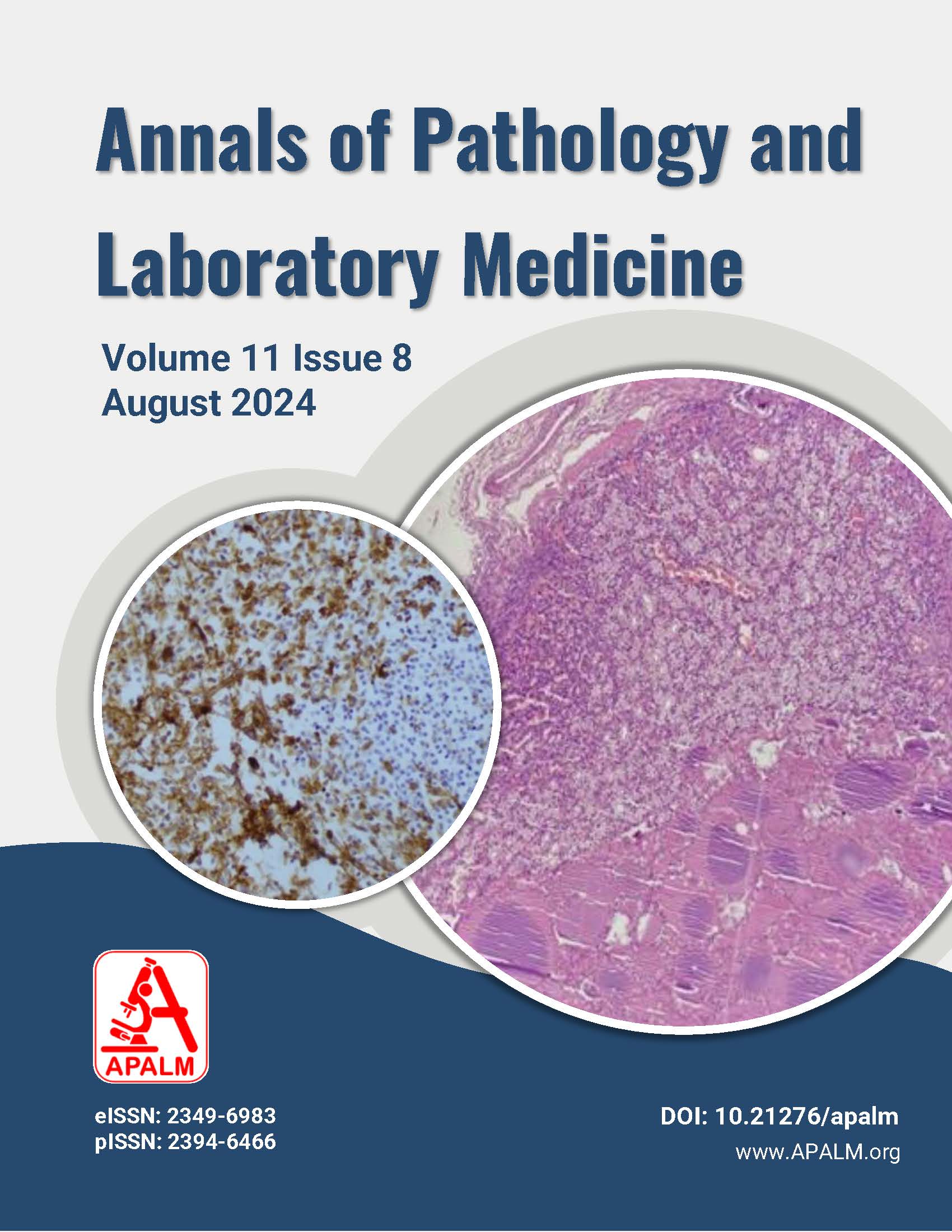Histopathological Patterns of Endometrial Biopsies in Abnormal Uterine Bleeding with Special Reference to Endometrial Carcinoma: A Study from North East India
DOI:
https://doi.org/10.21276/apalm.3357Keywords:
Abnormal uterine bleeding, Endometrial biopsy, Histopathological examination, Endometrial carcinoma, Endometrial hyperplasia, Precursor lesions of the endometriumAbstract
Background: Abnormal uterine bleeding (AUB) is the most commonly presented gynecological symptom in women of all age groups. Endometrial sampling followed by its histopathological examination is an indispensable tool to investigate the cause of AUB.
Materials and Methods: The study was a hospital-based cross-sectional study that included 272 endometrial biopsies sent to the Pathology department for histopathological examination. The duration of the study was one year. Only endometrial biopsies for non-gestational AUB were included in the study. After processing the formalin-fixed tissue, paraffin blocks were made. Four-micron thick slides were prepared, stained with Hematoxylin & Eosin stain, and thoroughly examined under scanner, low, and high-power view. The samples were categorized by age groups and clinical presentation of uterine bleeding. The study was approved by the Institutional Ethics Committee.
Results: Out of 272 endometrial biopsies, 254 biopsies could be evaluated, as 18 were non-diagnostic due to cellular inadequacy. The majority of the patients (42.1%) were in the 41—50 years age group. Normal cyclical changes (35.8%) constituted the most common histopathological findings, followed by disordered proliferative endometrium (27.9%). Malignant lesions were detected in 1.2% of cases, while endometrial hyperplasia constituted 26.4% of cases, emphasizing the importance of endometrial biopsies in detecting precursor lesions and treating them in their early pre-invasive stages, thereby reducing morbidity and mortality (p-value 0.0001).
Conclusion: Endometrial sampling should be considered in all cases presenting with AUB. Histopathological examination of the endometrium should be regarded as the first-line investigative modality in peri- and post-menopausal age groups, where the incidence of endometrial hyperplasia and endometrial carcinoma is higher.
References
Sanjita, Khanam I. Study of histopathological findings of endometrial biopsy in women with abnormal uterine bleeding. Int J Reprod Contracept Obstet Gynecol. 2023 May;12(5):1435-7.
Vijayaraghavan Sr A, Jadhav C, Pradeep B, Bindu H, Kumaran S, Pradeep BK, et al. A histopathological study of endometrial biopsy samples in abnormal uterine bleeding. Cureus. 2022 Nov 8;14(11)
Madueke-Laveaux OS, Elsharoud A, Al-Hendy A. What we know about the long-term risks of hysterectomy for benign indication—a systematic review. J Clin Med. 2021 Nov 16;10(22):5335.
Al Nemer AM, Al Bayat MI, Al Qahtani NH. The accuracy of endometrial sampling for the diagnosis of patterns of endometrial pathology in women presenting with abnormal uterine bleeding: more conservative therapeutic approaches. Saudi Med J. 2019 Aug;40(8):815-9.
Barros VV, Hase EA, Salazar CC, Igai AMK, Orsi FA, Margarido PFR. Abnormal uterine bleeding and chronic iron deficiency. Rev Bras Ginecol Obstet. 2022 Dec;44(12):1161-8.
Abdol Manap N, Ng BK, Phon SE, Abdul Karim AK, Lim PS, Fadhil M. Endometrial cancer in pre-menopausal women and younger: risk factors and outcome. Int J Environ Res Public Health. 2022;19(15):9059.
Bindhuja J. Histomorphologic study of endometrium in cases of abnormal uterine bleeding. J Pathol Nepal. 2023;13(1):1983-6.
Prathipaa R, Divya J. Histopathological study of endometrial samples in abnormal uterine bleeding. Indian J Pathol Oncol. 2020;7(4):567-70.
Sharma R, Mishra P, Kumar N, Srivastava P. Histomorphological spectrum of endometrial lesions in women presenting with abnormal uterine bleeding: a 3-year study at a tertiary care center. Trop J Pathol Microbiol. 2018;4(7):525-31.
Hyanki G, Pant P, Rizvi G. Endometrial biopsy in abnormal uterine bleeding: an effective tool in minimizing unnecessary hysterectomies. Saudi J Pathol Microbiol. 2019 Jan;4(1):21-5.
Sharma K, Rasania A. Clinicopathological spectrum of endometrial biopsies in a tertiary care center. Int J Sci Res. 2019;8(7):4.
Singh G, Cue L, Puckett Y. Endometrial hyperplasia. [Updated 2024 Apr 30]. In: StatPearls [Internet]. Treasure Island (FL): StatPearls Publishing; 2024 Jan-. Available from: https://www.ncbi.nlm.nih.gov/books/NBK560693/
Shah R, Dayal A, Kothari S, Patel S, Dalal B. Histopathological interpretation of endometrium in abnormal uterine bleeding. Int J Med Sci Public Health. 2014;3:452-6.
Zothansangi, Vanremmawii, Naveen P. Histopathological evaluation of endometrial tissue in patients of abnormal uterine bleeding. Int J Reprod Contracept Obstet Gynecol. 2022 Jan 1;11(1):69-74.
Dwivedi SS, Bajpai M, Bhushan I, Satkirti A. Spectrum of endometrial lesions observed on histopathological examination of endometrial samples in women with abnormal uterine bleeding. Int J Res Med Sci. 2019 Nov;7(11):4124-8.
Singh P. Abnormal uterine bleeding—evaluation by endometrial aspiration. J Midlife Health. 2018 Jan;9(1):32.
Downloads
Published
Issue
Section
License
Copyright (c) 2024 Daljeet Kaur, Junu Devi, Valina Brahma, Nani Kanya

This work is licensed under a Creative Commons Attribution 4.0 International License.
Authors who publish with this journal agree to the following terms:
- Authors retain copyright and grant the journal right of first publication with the work simultaneously licensed under a Creative Commons Attribution License that allows others to share the work with an acknowledgement of the work's authorship and initial publication in this journal.
- Authors are able to enter into separate, additional contractual arrangements for the non-exclusive distribution of the journal's published version of the work (e.g., post it to an institutional repository or publish it in a book), with an acknowledgement of its initial publication in this journal.
- Authors are permitted and encouraged to post their work online (e.g., in institutional repositories or on their website) prior to and during the submission process, as it can lead to productive exchanges, as well as earlier and greater citation of published work (See The Effect of Open Access at http://opcit.eprints.org/oacitation-biblio.html).










